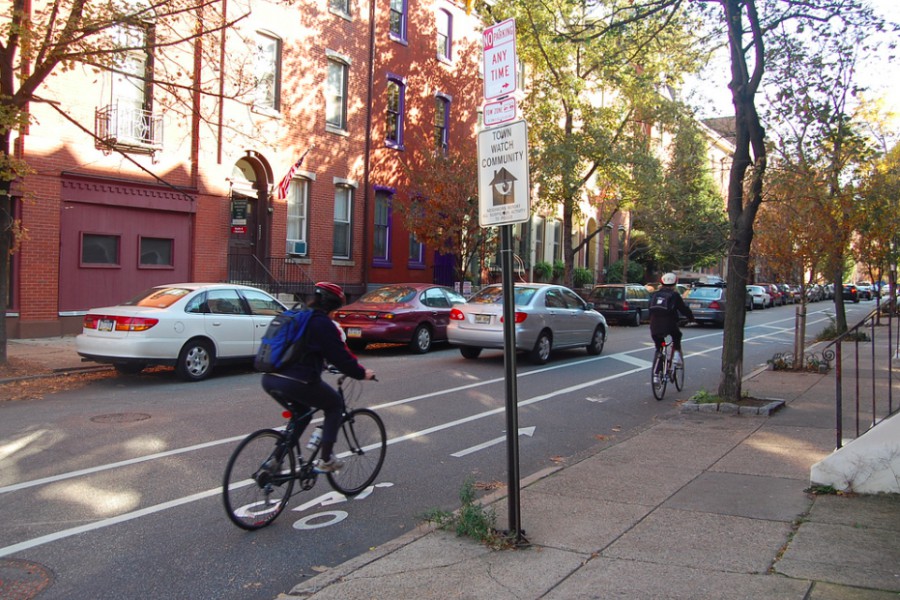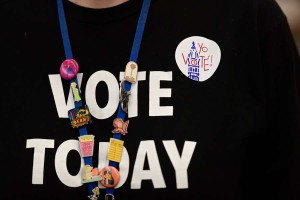How the Revamped Spruce and Pine Bike Lanes Lost a Safety Feature in Society Hill
The two lanes didn’t receive intersection protection after members of a community association opposed plastic delineator posts. Now cyclists — and some residents — are fed up.

Image via the Bicycle Coalition of Greater Philadelphia
The newly repaved Spruce and Pine street bike lanes feel like the future of street infrastructure in Philly: They’re smooth and well-marked, and ultimately allow bicyclists to feel significantly safer and legitimized on the roads. At most intersections where turning drivers run the risk of crossing a cyclist’s path — a move that claimed a 24-year-old’s life on Spruce Street in November 2017 — you’ll now find plastic delineator posts, which encourage people behind the wheel to slow down, pay attention to their surroundings, and make relatively wide turns.
Those posts don’t exist east of 8th Street, in Society Hill, though. That’s because back in 2017, the area’s neighborhood group — the Society Hill Civic Association — told the city that its members opposed delineator posts along the roads. And despite safety concerns that have persisted on Spruce and Pine for years, the city acceded to the group’s wishes, making Society Hill the only neighborhood where the Spruce and Pine street bike lanes don’t have this additional safety measure.
Some background: The repaving project on these roads, two of the city’s most controversial when it comes to bike infrastructure, was discussed for at least a year and executed earlier this fall. Cyclists with the Bicycle Coalition of Greater Philadelphia had pushed to protect the bike lanes completely (by installing delineator posts along the full length of the bike lanes, not just at intersections), but community opposition was harsh, with some residents in Washington Square West worrying that the posts would prevent delivery truck drivers and others from using the bike lanes as unofficial temporary stopping zones, among other concerns.
The city’s Office of Transportation, Infrastructure and Sustainability, which oversees bike lanes, ultimately decided to move the lanes from the right to the left sides of the streets. Officials hoped doing so would reduce the risk of so-called right-hook turns — like the one that killed Emily Fredricks in 2017. In addition, the lanes received paint upgrades, including bright green markings extending into intersections, as well as the plastic delineator posts at various intersections to better separate turning cars from cyclists.
Plans for Intersection Protection: A Timeline
There are lots of question regarding when and where the decision not to install delineator posts in Society Hill originated. Here’s a rough timeline of what we know occurred:
- In late 2017, SHCA made it clear that members were opposed to adding physical barriers anywhere along the bike lanes in their neighborhood. Larry Spector, president of SHCA since January, said the association presented a petition to the city with around 500 signatures of neighbors opposed to the posts.
- In early 2018 (sometime in February or March, according to Complete Streets director Kelley Yemen), the city released preliminary plans, which include proposals for plastic delineator posts at intersections along the entire Spruce and Pine street corridor, including Society Hill.
- At some point later in 2018, Yemen said, the city removed plans for delineator posts in Society Hill after officials “got the impression” that the neighborhood group was staunchly opposed to them.
“We felt [the posts were] a key community concern in that area, and we could reduce strong opposition [to the bike lane switch] to mild opposition [by not including them],” Yemen said.
“No Discussion”
Now that the bike lane project is complete, word is out that the city did away with plans to install delineator posts in Society Hill. Cyclists (and some residents) are frustrated — and pinning blame on the SHCA.
Last week, nearly 30 Society Hill residents signed a petition saying they felt blindsided by the decision not to include posts east of 8th Street. The petitioners asked Spector and the rest of SHCA leadership to “reconsider” supporting delineator posts at intersections, as not including them “puts bicyclists and pedestrians at risk in our neighborhood.”
Spector, a business litigation attorney who’s served on the SHCA board for at least three years, maintains that the civic association never opposed installing posts specifically at intersections. Instead, he said, the petition only opposed adding posts along the roads in general. He said “there was no discussion at that point about putting delineators at corners only.” (A May 2018 newsletter from the SHCA, however, mentions the city’s proposal for delineator posts “at the end of various blocks,” as well as an OTIS plan presented to the neighborhood in April 2018 that included the possibility of posts at intersections.)
“I never was on notice that the city was considering corner delineators in Society Hill,” Spector said. “We were operating under the assumption, as the city has told us from the beginning, that there weren’t going to be delineators in Society Hill.”
Plus, Spector said, the city told the group that the bike lane plans had “nothing to do with conditions in Society Hill, recognizing that this is not what we call a high-danger zone, and there’s really no imperative for there being delineators here.”
Yemen said OTIS research confirms that crashes occur on Spruce and Pine less frequently east of 8th Street than in Washington West and Center City. Still, both a city study and a report conducted by the Boston-based civil engineering group Howard Stein Hudson (which was commissioned by the SHCA) recommended intersection protection along the lengths of the bike lanes, including in Society Hill. The latter, as Spector stressed, didn’t recommend delineator posts, but did suggest some other form of protection, such as curbed corner islands.
“Committed to Community Engagement”
OTIS remains open to the possibility of adding delineator posts in Society Hill, Yemen said, as well as addressing residents’ and cyclists’ concerns. City spokesperson Kelly CoFrancisco said the organization is “committed to community engagement … as an indispensable tool in providing infrastructure that meets Philadelphian’s needs.”
Spector said the SHCA reached out to both OTIS and the Bicycle Coalition to set up meetings regarding the posts. “What the association may or may not be open to can be determined by if we go back to our board [after the meetings] and there are some facts on the table that can be evaluated,” he said.
As for bicyclists like Randy LoBasso, policy manager of the Bicycle Coalition, why a neighborhood association ever had so much sway regarding a city project affecting road users across Philadelphia remains a question.
“The whole idea of relying on near neighbors to make decisions for the most vulnerable road users who pass through their neighborhood on public streets is not good,” LoBasso said on Twitter on Wednesday. “It’s about who’s able to show up to the meeting or, in some cases, who can pay to be part of the neighborhood group.”
“I realize that’s not new information, by the way,” he added. “But…That ‘system’ is made much, much worse when the decisions are made by just a few people behind closed doors.”


